Difference between revisions of "Embossed leather"
| (26 intermediate revisions by one user not shown) | |||
| Line 10: | Line 10: | ||
== The embossing of leather == | == The embossing of leather == | ||
| − | Embossing | + | Embossing is the art of producing raised patterns on the [[Leather grain - Grain side|natural grain]] of an [[Hide - Skin|animal skin]]. The [[Leather grain - Grain side|design]] is created by pressing rolling, or stamping. Embossments can cover the entire surface of a skin or just selected areas. |
| + | The pattern of the embossing can be the [[leather grain|grain pattern]] of an animal skin in order to create a more even surface overall or to emboss the grain structure of other [[exotic leather|animal species]]. But also all other kinds of patterns can be embossed on leather. | ||
| Line 25: | Line 26: | ||
<p align=center> | <p align=center> | ||
| − | [[bild:Praegung-Rindsleder-003.jpg| | + | [[bild:Praegung-Rindsleder-003.jpg|500px]] |
| − | [[bild:Goldprägung-Buch-01.jpg| | + | </p> |
| − | [[bild:Farbdruck-01.jpg| | + | <p align=center> |
| − | + | [[bild:Goldprägung-Buch-01.jpg|250px]] | |
| + | [[bild:Farbdruck-01.jpg|250px]] | ||
| + | </p> | ||
| + | <p align=center> | ||
| + | [[bild:Embossed-leather-bag-02.jpg|500px]] | ||
</p> | </p> | ||
<p align=center> | <p align=center> | ||
| − | ''Different embossing on [[Leather book cover|book covers]]: | + | ''Different embossing on [[Leather book cover|book covers]]: Blind Embossing - [[Gold leather|Gold embossing]] - Colour imprint.''<br></p> |
<p> </p> | <p> </p> | ||
===The parameters that influence the embossing:=== | ===The parameters that influence the embossing:=== | ||
| − | * The pressure | + | * The amount of pressure used to stamp the tools into the leather -> The higher the pressure, the stronger and more durable the embossing. |
| − | * The time required for the stamping -> The longer the stamping pressure, the stronger and more durable the | + | * The time required for the stamping -> The longer the stamping pressure, the stronger and more durable the embossing. |
| − | * The temperature | + | * The temperature used -> The hotter the tool, the stronger and more durable the embossing. |
| − | * The moisture of the leather -> Imprints in damp leather | + | * The moisture content of the leather -> Imprints in damp leather are clearer and more durable. |
| − | + | Prior to embossing, leather may be [[Leather lamination - Laminating leather|bonded with foam and lining on the back]] so that the embossed pattern sits neatly and retains its depth. Sometimes a fabric is glued to the back to prevent stretching and flattening of the embossed motif. Deeply imprinted motifs need to be stabilised with fillers. There is a wide variety of filling materials that can be used, from papier mâché to hot glue, but the decisive factors are their stability and flexibility. | |
<p align=center> | <p align=center> | ||
| − | [[bild:Prägung-02.jpg| | + | [[bild:Prägung-02.jpg|500px]] |
| − | [[bild:Prägung-01.jpg| | + | </p> |
| + | <p align=center> | ||
| + | [[bild:Prägung-01.jpg|520px]] | ||
| + | </p> | ||
| + | <p align=center> | ||
| + | ''Leather [[Hide - Skin|hides]] in the embossing machine.'' | ||
</p> | </p> | ||
| + | |||
| + | <p align=center> | ||
| + | [[bild:Leather-embossing-fold-closed.jpg|500px]] | ||
| + | </p> | ||
| + | <p align=center> | ||
| + | [[bild:Leather-embossing-fold-up.jpg|500px]] | ||
| + | </p> | ||
<p align=center> | <p align=center> | ||
[[bild:Embossing leather-02.jpg|500px]] | [[bild:Embossing leather-02.jpg|500px]] | ||
</p> | </p> | ||
<p align=center> | <p align=center> | ||
| − | '' | + | ''The folds remained closed in the embossing machine and were not embossed.'' |
</p> | </p> | ||
| Line 61: | Line 78: | ||
</p> | </p> | ||
<p align=center> | <p align=center> | ||
| − | [[bild:19-Prägung-01.jpg| | + | [[bild:19-Prägung-01.jpg|500px]] |
| − | + | ||
</p> | </p> | ||
<p align=center> | <p align=center> | ||
| − | '' | + | [[bild:19-Prägung-02.jpg|500px]] |
| + | </p> | ||
| + | <p align=center> | ||
| + | ''Roller of an embossing machine in a [[tannery|leather factory]].'' | ||
</p> | </p> | ||
<p align=center> | <p align=center> | ||
| − | [[bild:Prägeplatte-01.jpg| | + | [[bild:Prägeplatte-01.jpg|500px]] |
| − | [[bild:Prägeplatte-02.jpg| | + | </p> |
| + | <p align=center> | ||
| + | [[bild:Prägeplatte-02.jpg|500px]] | ||
</p> | </p> | ||
<p align=center> | <p align=center> | ||
| Line 84: | Line 105: | ||
''[[Crocodile leather|Crocodile]] pattern by embossing plate.'' | ''[[Crocodile leather|Crocodile]] pattern by embossing plate.'' | ||
</p> | </p> | ||
| − | |||
<p align=center> | <p align=center> | ||
| − | [[bild:Praegewerkzeug-02.jpg| | + | [[bild:Praegewerkzeug-02.jpg|500px]] |
| − | + | ||
</p> | </p> | ||
| + | <p align=center> | ||
| + | [[bild:Praegewerkzeug-01.jpg|500px]] | ||
| + | </p> | ||
| + | <p align=center> | ||
| + | [[bild:Praegewerkzeug-03.jpg|500px]] | ||
| + | </p> | ||
| + | <p align=center> | ||
| + | ''Embossing stamps are sometimes milled. - VOLVO-Logo embossed in [[car leather]] ([http://www.ledermanufaktur.com www.ledermanufaktur.com]).'' | ||
| + | </p> | ||
| + | |||
<p align=center> | <p align=center> | ||
| − | [[bild: | + | [[bild:Leather embossing stamps.jpg|500px]] |
| − | + | ||
</p> | </p> | ||
<p align=center> | <p align=center> | ||
| − | '' | + | ''A specialist for [https://www.les-graveurs.de/Lederpraegestempel leather embossing stamps: www.les-graveurs.de].'' |
</p> | </p> | ||
<p align=center> | <p align=center> | ||
| − | [[bild:Ford-Mustang-Prägung-01.jpg| | + | [[bild:Ford-Mustang-Prägung-01.jpg|500px]] |
| − | [[bild:Ford-Mustang-Prägung-02.jpg| | + | </p> |
| + | <p align=center> | ||
| + | [[bild:Ford-Mustang-Prägung-02.jpg|500px]] | ||
</p> | </p> | ||
<p align=center> | <p align=center> | ||
| Line 109: | Line 139: | ||
</p> | </p> | ||
<p align=center> | <p align=center> | ||
| − | ''Embossing in the imitation leather of a Ford Mustang.'' | + | ''Embossing in the [[Artificial leather - Imitation leather|imitation leather]] of a Ford Mustang.'' |
</p> | </p> | ||
| − | Due to the longer exposure time at a hydraulic press, the embossed motif is more | + | <p align=center> |
| + | <flashow>//www.youtube.com/v/6LqU0pafG6w&fs=1&color1=0x660000&color2=0x550000&border=1|width=500|height=281,25</flashow> | ||
| + | </p> | ||
| + | <p align=center> | ||
| + | ''[[Car leather]] can be branded by embossing, by [[embroidery]] or by [[Printing on leather|printing]].''<br></p> | ||
| + | <p> </p> | ||
| + | |||
| + | Due to the longer exposure time at a hydraulic press, the embossed motif is more stable than if it was applied with a roller. Depending on the temperature, pressure and length of time, the embossing is more or less clear and stable. Moisturising the leather afterwards stabilises the motifs. | ||
| Line 120: | Line 157: | ||
</p> | </p> | ||
<p align=center> | <p align=center> | ||
| − | ''The fine | + | ''The process needs to be fine-tuned to achieve good results. Too hot embossed [[aircraft leather]] is not good enough for "First Class".'' |
</p> | </p> | ||
| − | Embossing rollers and embossing stamps are expensive. Individual motifs are therefore often [[Carving leather|carved]]. | + | Embossing rollers and embossing stamps are expensive. Individual motifs are therefore often [[Carving leather|carved]]. It is also possible to create motifs on leather with lasers. |
| Line 140: | Line 177: | ||
</p> | </p> | ||
<p align=center> | <p align=center> | ||
| − | ''Embossed [[ | + | ''Embossed [[lamb leather]] used for [[Leather clothing|clothing]].'' |
</p> | </p> | ||
| Line 148: | Line 185: | ||
</p> | </p> | ||
<p align=center> | <p align=center> | ||
| − | ''Beautiful embossing on a strap made of [[elkskin leather]] | + | ''Beautiful embossing on a strap made of [[elkskin leather]].''<br></p> |
<p> </p> | <p> </p> | ||
| − | Almost any [[Types of leather|type of leather]] can be embossed. However, the embossing must be adjusted | + | Almost any [[Types of leather|type of leather]] can be embossed. However, the embossing must be adjusted, depending on the type of leather. The resistance of an embossing depends on the embossing process. The higher the pressure and the temperature, and the more moisture in the leather, the more permanent the reshaping of the fibre. But, of course, there are also limits to the pressure and temperature that can be applied to each leather. |
== Reasons for embossing leather: To provide leather with designs == | == Reasons for embossing leather: To provide leather with designs == | ||
| − | Often, leather is decorated | + | Often, leather is decorated to achieve a certain look. The grain structure of [[Exotic leather|other animals]] can also be copied. It is sometimes difficult to distinguish even for [[Leather expert - Leather consultant|experts]] if the [[Leather grain - Grain side|grain structure]] is from the original animal or only an embossed copy. |
| − | |||
<p align=center> | <p align=center> | ||
| − | <flashow> | + | <flashow>//www.youtube.com/v/sYzdxiXI-2g&fs=1&color1=0x660000&color2=0x550000&border=1|width=500|height=281,25</flashow> |
</p> | </p> | ||
<p align=center> | <p align=center> | ||
| Line 166: | Line 202: | ||
<p> </p> | <p> </p> | ||
| + | <p align=center> | ||
| + | [[bild:Guertel-Praegungen-01.jpg|250px]] | ||
| + | [[bild:Tasche-Praegung-Strauss-01.jpg|250px]] | ||
| + | </p> | ||
| + | <p align=center> | ||
| + | ''[[Embossed leather]] belt. - [[Ostrich leather]] embossing.''</p> | ||
| + | <p> </p> | ||
| − | <center> | + | <p align=center> |
| + | [[bild:Cigarette-case-leather-01.jpg|250px]] | ||
| + | [[bild:Prägung-Rindskopf-03.jpg|250px]] | ||
| + | </p> | ||
| + | <p align=center> | ||
| + | ''Embossed [[Leather accessories|case]]. - Embossed and [[Painting on leather|painted]].''</p> | ||
| + | <p> </p> | ||
| − | + | <p align=center> | |
| − | + | [[bild:Praegung-Stuhl-02-2011-12.jpg|250px]] | |
| − | + | [[bild:Praegung-Stuhl-03-2011-12.jpg|250px]] | |
| − | + | </p> | |
| − | + | <p align=center> | |
| − | + | ''Embossed antique leather very finely finished.''</p> | |
| − | + | <p> </p> | |
| − | + | ||
| − | + | ||
| − | + | ||
| − | + | ||
| − | + | ||
| − | + | ||
| − | + | ||
| − | + | ||
| − | + | ||
| − | + | ||
| − | + | ||
| − | + | ||
| − | + | ||
| − | + | ||
| − | + | ||
| − | + | ||
| − | + | ||
| − | + | ||
| − | + | ||
| − | + | ||
| − | + | ||
| − | + | ||
| − | + | ||
| − | </ | + | |
| + | <p align=center> | ||
| + | [[bild:mappe_praegung12.jpg|250px]] | ||
| + | [[bild:mappe_praegung14.jpg|250px]] | ||
| + | </p> | ||
| + | <p align=center> | ||
| + | ''[[Antique Leather - Vintage Leather|Antique]] leather folder from 1920 with beautiful embossing.''</p> | ||
<p> </p> | <p> </p> | ||
| − | |||
| − | |||
| − | |||
| − | |||
| − | |||
| − | |||
| − | |||
| − | |||
<p align=center> | <p align=center> | ||
| − | + | [[bild:Antiker-Stuhl-10.jpg|250px]] | |
| + | [[bild:Stuhl-Praegung-2011-10-07.jpg|250px]] | ||
</p> | </p> | ||
| − | + | <p align=center> | |
| + | ''[[Antique leather chairs]] are often decorated with a beautiful motif.''</p> | ||
| + | <p> </p> | ||
<p align=center> | <p align=center> | ||
| Line 221: | Line 247: | ||
</p> | </p> | ||
<p align=center> | <p align=center> | ||
| − | ''[[Leather handbags]] producers like to brand by embossing their company logos.'' | + | ''[[Leather handbags]] producers like to brand by embossing their company logos.''</p> |
| − | </p> | + | <p> </p> |
| − | + | ||
<p align=center> | <p align=center> | ||
| − | [[bild: | + | [[bild:Furniture-leather-embossing-03.jpg|500px]] |
| − | + | ||
</p> | </p> | ||
<p align=center> | <p align=center> | ||
| − | + | [[bild:Praegung-Rind-01.jpg|250px]] | |
| + | [[bild:Praegung-Rind-03.jpg|250px]] | ||
</p> | </p> | ||
| − | |||
| − | |||
<p align=center> | <p align=center> | ||
| − | [[bild: | + | [[bild:Furniture-leather-embossing-06.jpg|500px]] |
| − | + | ||
| − | + | ||
</p> | </p> | ||
<p align=center> | <p align=center> | ||
| Line 245: | Line 266: | ||
<p align=center> | <p align=center> | ||
| − | [[bild:Pferd-11.jpg| | + | [[bild:Pferd-11.jpg|500px]] |
| − | + | ||
</p> | </p> | ||
<p align=center> | <p align=center> | ||
| − | ''[[Top grain leather|Front]] and [[Flesh side|back | + | [[bild:Pferd-12.jpg|500px]] |
| + | </p> | ||
| + | <p align=center> | ||
| + | ''[[Top grain leather|Front]] and [[Flesh side|back]] of horse motive embossing.'' | ||
</p> | </p> | ||
<p align=center> | <p align=center> | ||
| − | [[bild:Pferd-07.jpg| | + | [[bild:Pferd-07.jpg|500px]] |
| − | [[bild:Pferd-08.jpg| | + | </p> |
| + | <p align=center> | ||
| + | [[bild:Pferd-08.jpg|500px]] | ||
</p> | </p> | ||
<p align=center> | <p align=center> | ||
| − | ''Horse stamping tool positive and negative as pictures above. - Two other variants of horse motifs | + | ''Horse stamping tool positive and negative as pictures above. - Two other variants of horse motifs.'' |
</p> | </p> | ||
| − | Usually embossing is done on the | + | Usually, embossing is done on the grain side by compressing the leather grain structure. The uncompressed leather fibres remain above. This creates a three-dimensional effect. Leather is sometimes embossed with two embossing plates from both sides (positive and negative). Then the recesses on the back must be stabilised to prevent the embossed motif from pressing down during use. |
| Line 274: | Line 299: | ||
</p> | </p> | ||
<p align=center> | <p align=center> | ||
| − | '' | + | ''Strong embossments in soft leathers are stabilised from the back with a silicone filling to prevent the embossing being pressed down from the front.'' |
</p> | </p> | ||
| Line 283: | Line 308: | ||
</p> | </p> | ||
<p align=center> | <p align=center> | ||
| − | '' | + | ''Back stabilised embossing of [[leather jacket|leather jackets]].'' |
</p> | </p> | ||
| Line 296: | Line 321: | ||
</p> | </p> | ||
<p align=center> | <p align=center> | ||
| − | ''[[Antique Leather - Vintage Leather|Antique Leather]] with a | + | ''[[Antique Leather - Vintage Leather|Antique Leather]] with a wax-based reinforcement (wax mixed with sand) at the back.'' |
</p> | </p> | ||
| Line 305: | Line 330: | ||
</p> | </p> | ||
<p align=center> | <p align=center> | ||
| − | ''Very exotic: [[Cow leather]] with an extremely strong embossing and [[Metallic leather| | + | ''Very exotic: [[Cow leather]] with an extremely strong embossing and [[Metallic leather|metallic effect]].'' |
</p> | </p> | ||
| Line 314: | Line 339: | ||
</p> | </p> | ||
<p align=center> | <p align=center> | ||
| − | '' | + | ''Unusually strong [[Formed leather|deformation]] of [[furniture leather]].'' |
</p> | </p> | ||
| Line 323: | Line 348: | ||
</p> | </p> | ||
<p align=center> | <p align=center> | ||
| − | '' | + | ''Embossed [[suede]].''<br></p> |
<p> </p> | <p> </p> | ||
| Line 330: | Line 355: | ||
</p> | </p> | ||
<p align=center> | <p align=center> | ||
| − | ''[[ | + | ''[[Crocodile leather|Crocodile]] embossing in [[Artificial leather - Imitation leather|imitation leather]].''<br></p> |
<p> </p> | <p> </p> | ||
| − | == Reasons for embossing leather: Correction of the [[Leather grain | + | == Reasons for embossing leather: Correction of the [[Leather grain - Grain side|leather grain pattern]] == |
| − | + | Another reason for embossing [[Hide - Skin|hides]] is to obscure [[natural markings on leather]]. Therefore, the surface is [[Sanding leather|sanded]] and repaired before embossing. Such leather is called ‘corrected grain’. | |
| − | + | A farmer doesn’t get any more money from the butcher for his cows and cattle, if the skin is flawless. During their lifetime, animals suffer [[natural markings on leather|wounds and marks]] that affect the quality of the leather surface. Embossing is used to hide insect bites, injuries, illnesses and other damages on animal [[Hide - Skin|skins]] and to create a uniform grain. | |
| − | + | This reduces [[Leather cutting waste|wastage]], as the entire surface of a skin gets a uniform [[Leather grain - Grain side|grain pattern]]. All parts of a set of [[furniture leather|furniture]] or [[car leather|car interiors]] will be identical. Minor flaws and irregularities of the natural grain can be balanced and must not be circumvented when [[Leather cutting|cutting]] the leather. | |
| − | === [[Leather grain texture]] === | + | === [[Leather grain - Grain side|Leather grain texture]] === |
| − | + | A natural [[Leather hair pores - Hair follicles#fine pore leather - coarse pore leather - fine grain leather - coarse grain leather|leather grain]] varies across the [[Hide - Skin|skin surface]]. In the middle of a skin the leather is mostly fine grained, while towards the edge it has a coarse grain. | |
| + | |||
| + | When [[Leather cutting|cutting]] seating surfaces for [[leather furniture|furniture]] and [[car leather|vehicles]], the customers value a uniform grain structure. Due to the uniform embossing, the grain structure is identical across the hide. | ||
| Line 351: | Line 378: | ||
</p> | </p> | ||
<p align=center> | <p align=center> | ||
| − | '' | + | ''On one hide: [[Leather hair pores - Hair follicles#fine pore leather - coarse pore leather - fine grain leather - coarse grain leather|fine grain]] - transition - [[Leather hair pores - Hair follicles#fine pore leather - coarse pore leather - fine grain leather - coarse grain leather|coarse grain]].'' |
</p> | </p> | ||
=== Unembossed leather === | === Unembossed leather === | ||
| − | + | For any tannery, the scale of costs depends on the number of hides which can be used. [[Hide - Skin|Skins]] that are not good enough for processing as [[Full grain leather|full-grain leather]] can be embossed. Only about 10-20% of the hides coming from the slaughterhouse are ‘good’ to ‘very good’ [[leather quality|quality]]. Embossing does not reduce the quality of the leather. Provided that it is not hiding damage that could affect the life expectancy of the leather, embossing is perfectly acceptable. | |
<p align=center> | <p align=center> | ||
| − | [[bild:Pigmentierung-Poren-004.jpg| | + | [[bild:Pigmentierung-Poren-004.jpg|500px]] |
| − | [[bild:Pigmentierung-Poren-002.jpg| | + | </p> |
| − | [[bild:Pigmentierung-Poren-001.jpg| | + | <p align=center> |
| + | [[bild:Pigmentierung-Poren-002.jpg|250px]] | ||
| + | [[bild:Pigmentierung-Poren-001.jpg|250px]] | ||
</p> | </p> | ||
<p align=center> | <p align=center> | ||
| − | '' | + | ''Unembossed leather. - The hair pores are still visible (click to enlarge).'' |
</p> | </p> | ||
| − | ===Corrected | + | ===Corrected grain - sanded and embossed leather === |
| − | + | In preparation for embossing, the leather is mostly [[Sanding leather|sanded]] to obtain a uniform structure. Such leather is called ‘corrected grain’. It is cheaper and feels [[Haptic evaluation of leather surfaces|colder and plastic like]]. The [[Breathability of leather| breathability of such leather]] is significantly lower when compared with [[Leather hair pores - Hair follicles|porous leathers]]. There is also leather which is only lightly [[Sanding leather|sanded]] making it [[Haptic evaluation of leather surfaces|soft and warm]] to the touch. But this is more the exception. A hair pore structure is often also embossed to give the leather a natural look and make it appear more valuable than it is. | |
<p align=center> | <p align=center> | ||
| − | [[bild:Pigmentierung-gepraegt-003.jpg| | + | [[bild:Pigmentierung-gepraegt-003.jpg|500px]] |
| − | + | ||
| − | + | ||
</p> | </p> | ||
<p align=center> | <p align=center> | ||
| − | '' | + | [[bild:Pigmentierung-gepraegt-002.jpg|250px]] |
| + | [[bild:Pigmentierung-gepraegt-001.jpg|250px]] | ||
| + | </p> | ||
| + | <p align=center> | ||
| + | ''Embossed and [[Sanding leather|sanded]] leather. - The [[Leather hair pores - Hair follicles|hair follicles]] are sanded away and over embossed.'' | ||
</p> | </p> | ||
| + | |||
| + | <p align=center> | ||
| + | [[bild:Smooth leather pores embossed pigmented.jpg|500px]] | ||
| + | </p> | ||
| + | <p align=center> | ||
| + | 'The [[Leather hair pores - Hair follicles|hair pore structure]] on this sanded and pigmented leather is not natural but embossed.''<br></p> | ||
| + | <p> </p> | ||
| + | |||
| + | <p align=center> | ||
| + | [[bild:Semianilinleder-Falschdeklaration-04.jpg|500px]] | ||
| + | </p> | ||
| + | <p align=center> | ||
| + | ''After removing the [[pigmented leather|surface coloring]] with a solvent: [[Sanding leather|Sanded]], pigmented and embossed with [[Leather hair pores - Hair follicles|hair pores]]. Visible hair pores alone are not a sign of [[leather quality|high quality]].''<br></p> | ||
| + | <p> </p> | ||
=== Embossed leather without [[Sanding leather|sanding]] === | === Embossed leather without [[Sanding leather|sanding]] === | ||
| − | + | The [[Sanding leather|sanding]] stage prior to embossing is sometimes forbidden by car manufacturers to prevent the use of lower quality hides. | |
<p align=center> | <p align=center> | ||
| − | [[bild:Autoleder-Praegung-ungesch2.jpg| | + | [[bild:Autoleder-Praegung-ungesch2.jpg|500px]] |
| − | [[bild:Moebelleder-Praegung-ungesschliffen-0022.jpg| | + | </p> |
| − | [[bild:Autoleder-Praegung-ungescchliffen-BMW-Picasso-002.jpg| | + | <p align=center> |
| + | [[bild:Moebelleder-Praegung-ungesschliffen-0022.jpg|250px]] | ||
| + | [[bild:Autoleder-Praegung-ungescchliffen-BMW-Picasso-002.jpg|250px]] | ||
</p> | </p> | ||
<p align=center> | <p align=center> | ||
| Line 399: | Line 446: | ||
<p> </p> | <p> </p> | ||
| − | + | == Other methods of adding designs on leather == | |
| − | + | ||
| − | + | ||
| − | == Other | + | |
* [[Carving leather]] | * [[Carving leather]] | ||
* [[Laser engraving - Laser cutting leather]] | * [[Laser engraving - Laser cutting leather]] | ||
| Line 417: | Line 461: | ||
* [[Glued leather strips]] | * [[Glued leather strips]] | ||
* [[Burning designs on leather]] | * [[Burning designs on leather]] | ||
| − | |||
== Additional information == | == Additional information == | ||
Latest revision as of 13:34, 20 July 2023
Contents
The embossing of leather
Embossing is the art of producing raised patterns on the natural grain of an animal skin. The design is created by pressing rolling, or stamping. Embossments can cover the entire surface of a skin or just selected areas. The pattern of the embossing can be the grain pattern of an animal skin in order to create a more even surface overall or to emboss the grain structure of other animal species. But also all other kinds of patterns can be embossed on leather.
Types of embossing
- Blind Embossing, blind printing, blind finishing: Embossing of leather without colour.
- Gold embossing: The transfer of gold leaf into the embossing.
- Colour imprint: The transmission of colour by colour films in the embossment.
Different embossing on book covers: Blind Embossing - Gold embossing - Colour imprint.
The parameters that influence the embossing:
- The amount of pressure used to stamp the tools into the leather -> The higher the pressure, the stronger and more durable the embossing.
- The time required for the stamping -> The longer the stamping pressure, the stronger and more durable the embossing.
- The temperature used -> The hotter the tool, the stronger and more durable the embossing.
- The moisture content of the leather -> Imprints in damp leather are clearer and more durable.
Prior to embossing, leather may be bonded with foam and lining on the back so that the embossed pattern sits neatly and retains its depth. Sometimes a fabric is glued to the back to prevent stretching and flattening of the embossed motif. Deeply imprinted motifs need to be stabilised with fillers. There is a wide variety of filling materials that can be used, from papier mâché to hot glue, but the decisive factors are their stability and flexibility.
Leather hides in the embossing machine.
The folds remained closed in the embossing machine and were not embossed.
Roller of an embossing machine in a leather factory.
Embossing plates: coarse grain leather and pig skin grain.
Crocodile pattern by embossing plate.
Embossing stamps are sometimes milled. - VOLVO-Logo embossed in car leather (www.ledermanufaktur.com).
A specialist for leather embossing stamps: www.les-graveurs.de.
Embossing in the imitation leather of a Ford Mustang.
Car leather can be branded by embossing, by embroidery or by printing.
Due to the longer exposure time at a hydraulic press, the embossed motif is more stable than if it was applied with a roller. Depending on the temperature, pressure and length of time, the embossing is more or less clear and stable. Moisturising the leather afterwards stabilises the motifs.
The process needs to be fine-tuned to achieve good results. Too hot embossed aircraft leather is not good enough for "First Class".
Embossing rollers and embossing stamps are expensive. Individual motifs are therefore often carved. It is also possible to create motifs on leather with lasers.
Embossed furniture leather.
Embossed lamb leather used for clothing.
Beautiful embossing on a strap made of elkskin leather.
Almost any type of leather can be embossed. However, the embossing must be adjusted, depending on the type of leather. The resistance of an embossing depends on the embossing process. The higher the pressure and the temperature, and the more moisture in the leather, the more permanent the reshaping of the fibre. But, of course, there are also limits to the pressure and temperature that can be applied to each leather.
Reasons for embossing leather: To provide leather with designs
Often, leather is decorated to achieve a certain look. The grain structure of other animals can also be copied. It is sometimes difficult to distinguish even for experts if the grain structure is from the original animal or only an embossed copy.
A video about painting on leather, perforating leather, carving leather, embossing leather and several other methods to create motifs on leather.
Embossed leather belt. - Ostrich leather embossing.
Embossed case. - Embossed and painted.
Embossed antique leather very finely finished.
Antique leather folder from 1920 with beautiful embossing.
Antique leather chairs are often decorated with a beautiful motif.
Leather handbags producers like to brand by embossing their company logos.
Modern patterns embossed in cow leather.
Front and back of horse motive embossing.
Horse stamping tool positive and negative as pictures above. - Two other variants of horse motifs.
Usually, embossing is done on the grain side by compressing the leather grain structure. The uncompressed leather fibres remain above. This creates a three-dimensional effect. Leather is sometimes embossed with two embossing plates from both sides (positive and negative). Then the recesses on the back must be stabilised to prevent the embossed motif from pressing down during use.
Strong embossments in soft leathers are stabilised from the back with a silicone filling to prevent the embossing being pressed down from the front.
Back stabilised embossing of leather jackets.
Antique Leather with a wax-based reinforcement (wax mixed with sand) at the back.
Very exotic: Cow leather with an extremely strong embossing and metallic effect.
Unusually strong deformation of furniture leather.
Embossed suede.
Crocodile embossing in imitation leather.
Reasons for embossing leather: Correction of the leather grain pattern
Another reason for embossing hides is to obscure natural markings on leather. Therefore, the surface is sanded and repaired before embossing. Such leather is called ‘corrected grain’.
A farmer doesn’t get any more money from the butcher for his cows and cattle, if the skin is flawless. During their lifetime, animals suffer wounds and marks that affect the quality of the leather surface. Embossing is used to hide insect bites, injuries, illnesses and other damages on animal skins and to create a uniform grain.
This reduces wastage, as the entire surface of a skin gets a uniform grain pattern. All parts of a set of furniture or car interiors will be identical. Minor flaws and irregularities of the natural grain can be balanced and must not be circumvented when cutting the leather.
Leather grain texture
A natural leather grain varies across the skin surface. In the middle of a skin the leather is mostly fine grained, while towards the edge it has a coarse grain.
When cutting seating surfaces for furniture and vehicles, the customers value a uniform grain structure. Due to the uniform embossing, the grain structure is identical across the hide.
On one hide: fine grain - transition - coarse grain.
Unembossed leather
For any tannery, the scale of costs depends on the number of hides which can be used. Skins that are not good enough for processing as full-grain leather can be embossed. Only about 10-20% of the hides coming from the slaughterhouse are ‘good’ to ‘very good’ quality. Embossing does not reduce the quality of the leather. Provided that it is not hiding damage that could affect the life expectancy of the leather, embossing is perfectly acceptable.
Unembossed leather. - The hair pores are still visible (click to enlarge).
Corrected grain - sanded and embossed leather
In preparation for embossing, the leather is mostly sanded to obtain a uniform structure. Such leather is called ‘corrected grain’. It is cheaper and feels colder and plastic like. The breathability of such leather is significantly lower when compared with porous leathers. There is also leather which is only lightly sanded making it soft and warm to the touch. But this is more the exception. A hair pore structure is often also embossed to give the leather a natural look and make it appear more valuable than it is.
Embossed and sanded leather. - The hair follicles are sanded away and over embossed.
'The hair pore structure on this sanded and pigmented leather is not natural but embossed.
After removing the surface coloring with a solvent: Sanded, pigmented and embossed with hair pores. Visible hair pores alone are not a sign of high quality.
Embossed leather without sanding
The sanding stage prior to embossing is sometimes forbidden by car manufacturers to prevent the use of lower quality hides.
Embossed, but not sanded leather. The hair pores are still clearly visible.
Car leather from BMW with "Montana" embossment. - Strong embossed furniture leather. - BMW with "Picasso" embossment.
Other methods of adding designs on leather
- Carving leather
- Laser engraving - Laser cutting leather
- Perforated leather
- Hole punching
- Embroidery
- Leather seams
- Leather imprint
- Formed leather
- Painting on leather
- Braided leather
- Leather etching & engraving
- Leather tattoo
- Glued leather strips
- Burning designs on leather
Additional information







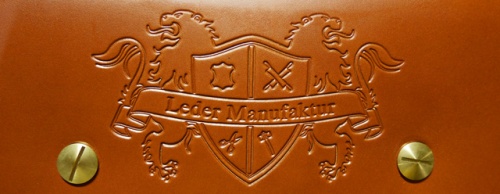

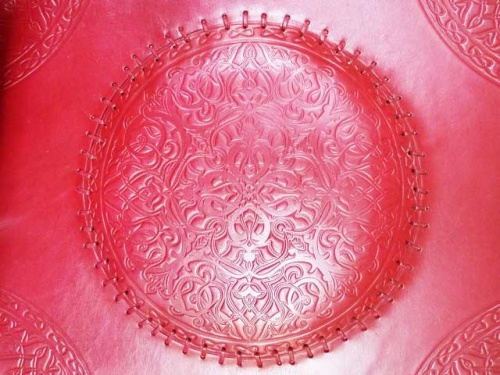
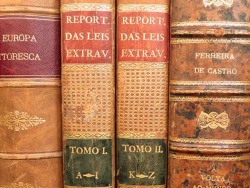
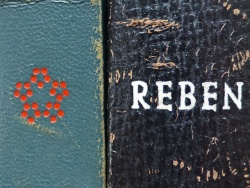
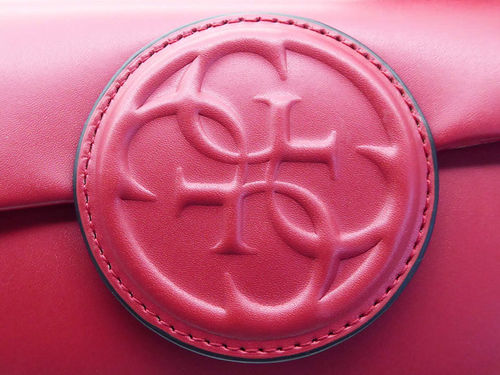
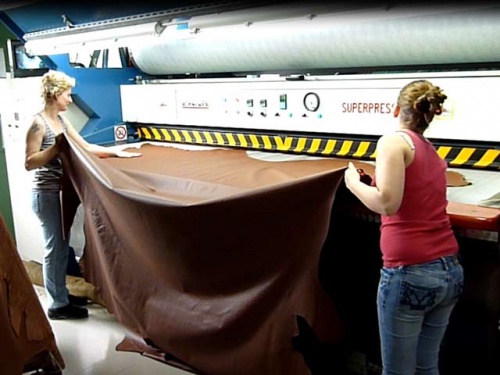
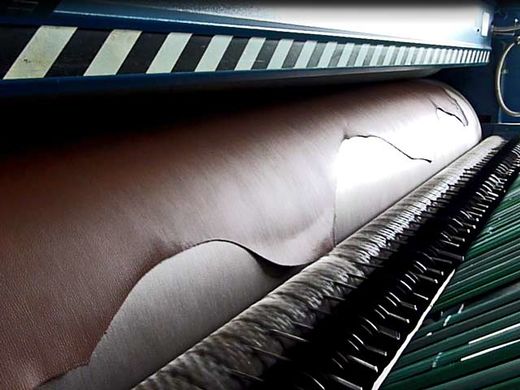
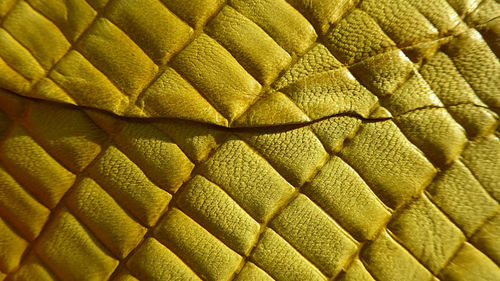
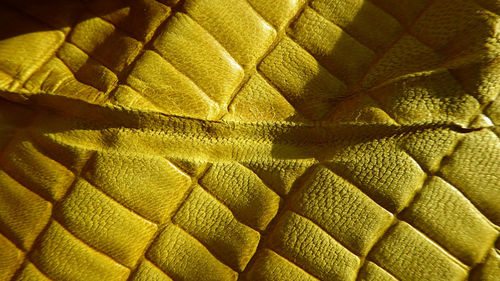
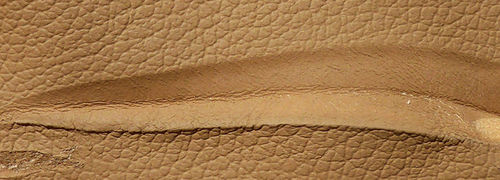
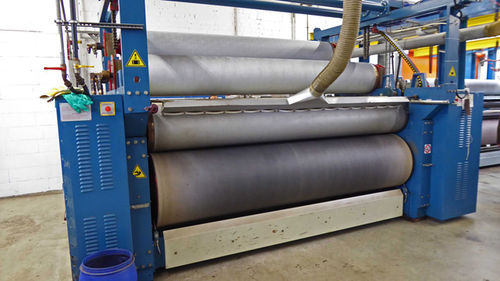
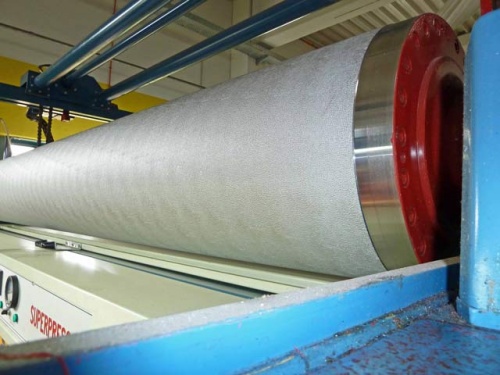
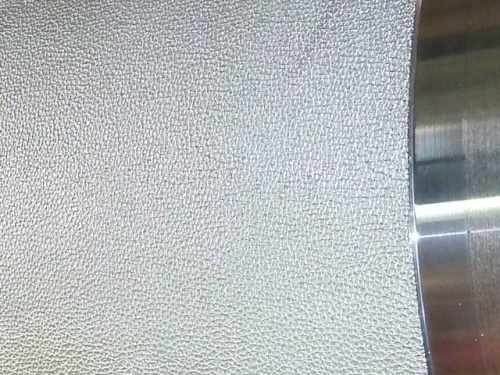
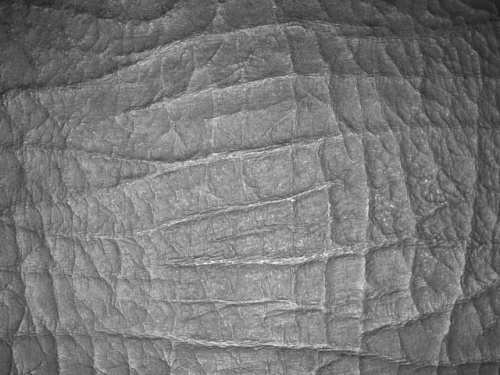
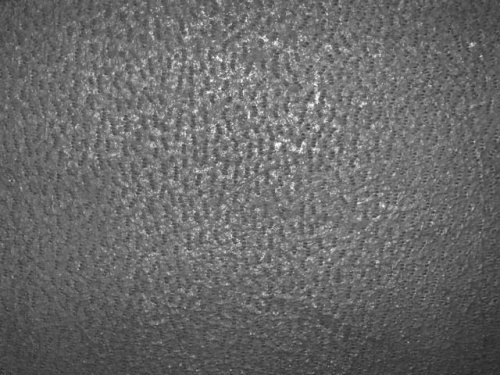
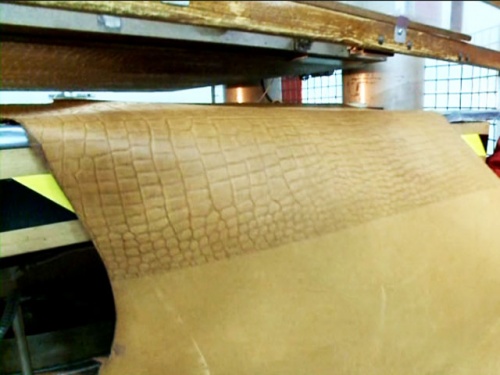
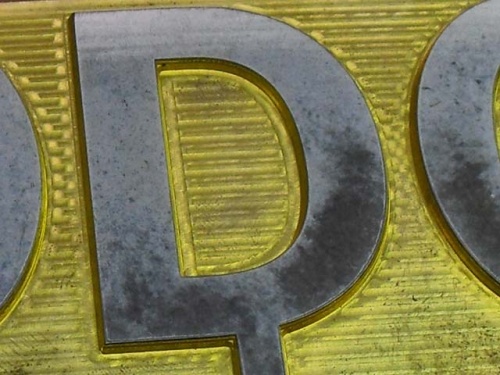
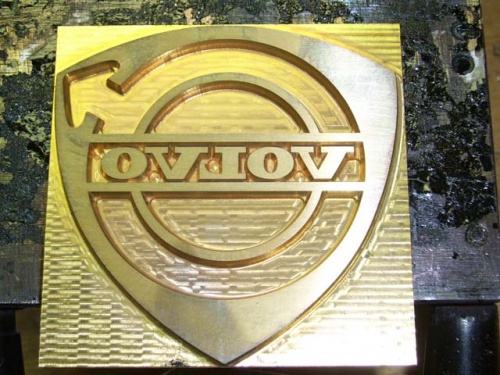
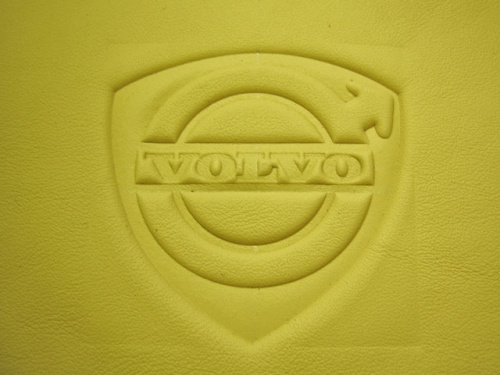
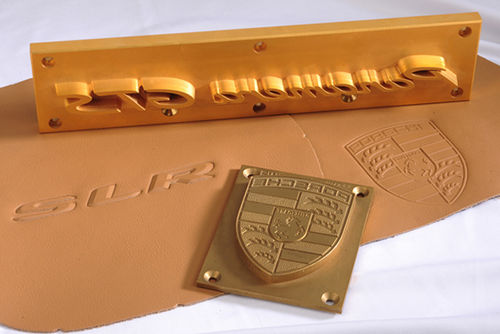









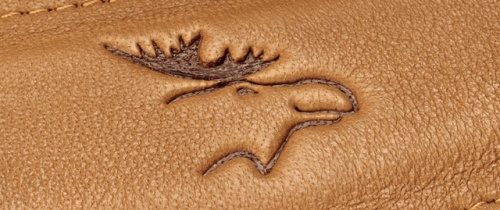
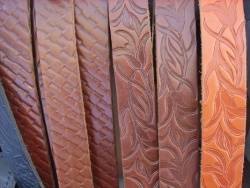
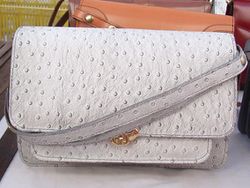
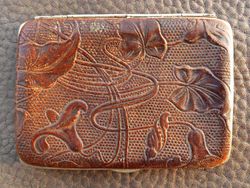
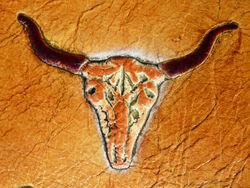
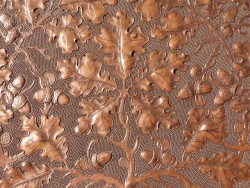
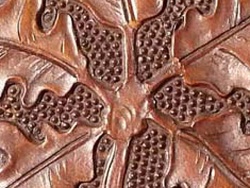
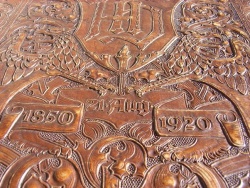
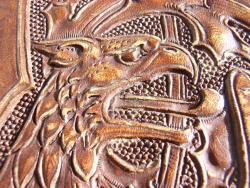
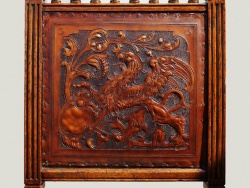
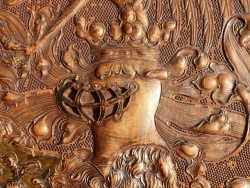
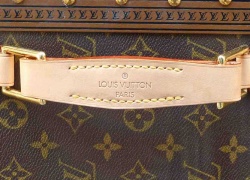
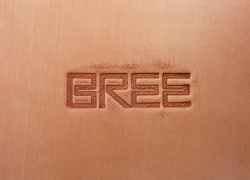

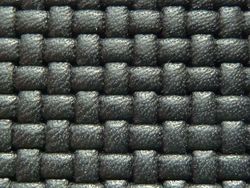
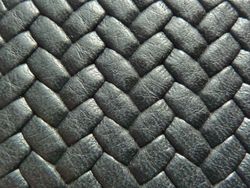

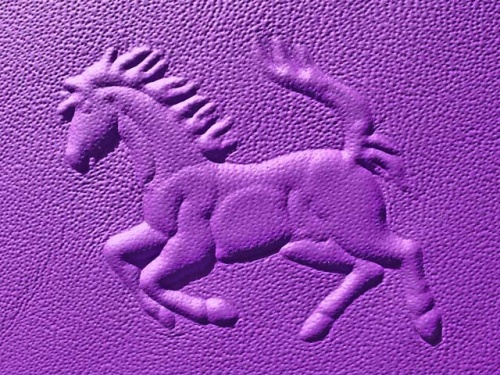
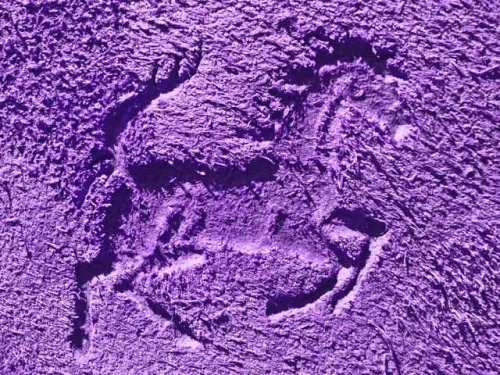
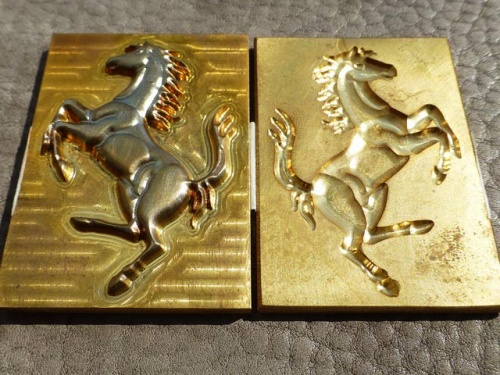
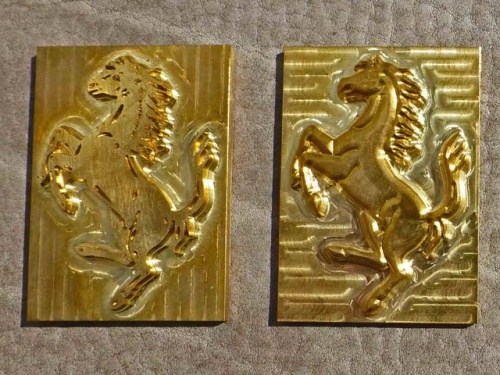
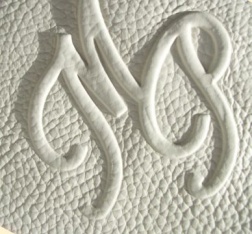
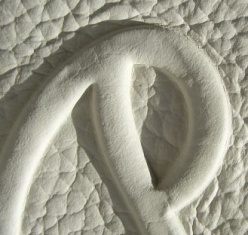
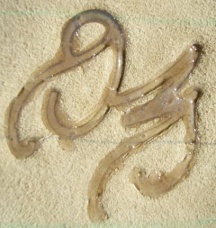
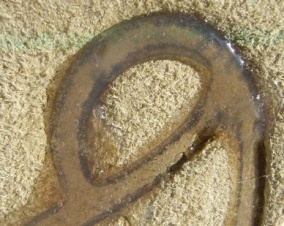
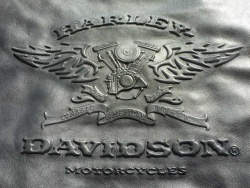
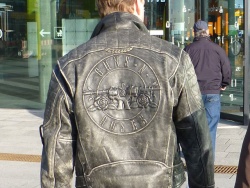
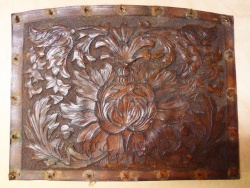
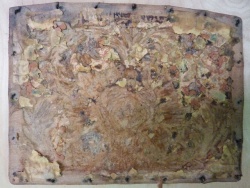
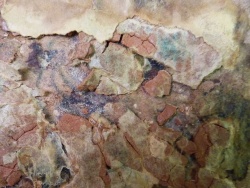
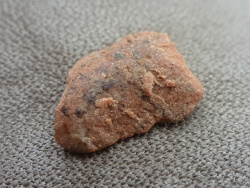
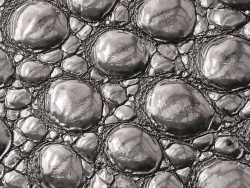
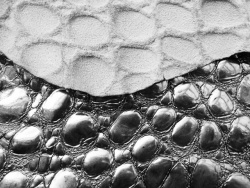
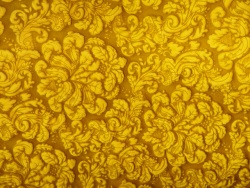
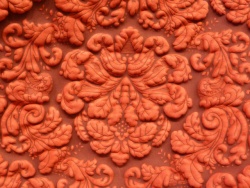
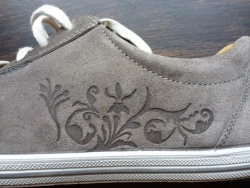
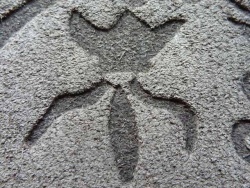
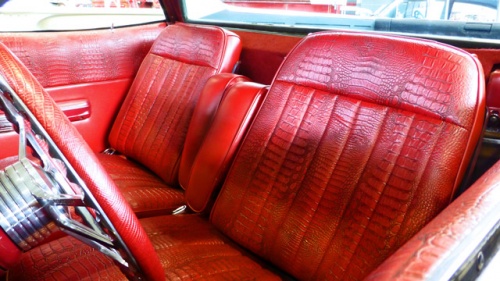
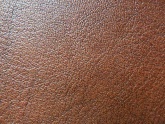
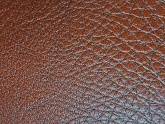
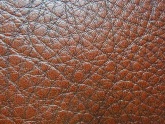
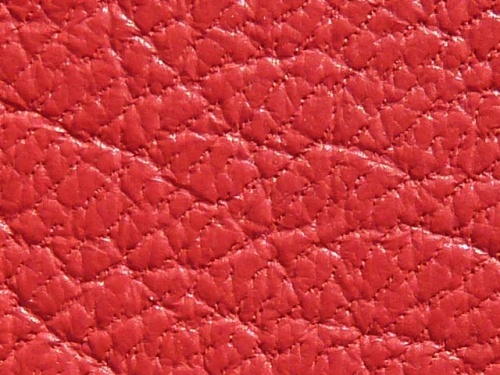
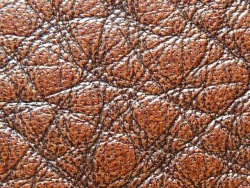
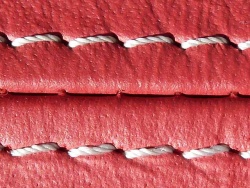
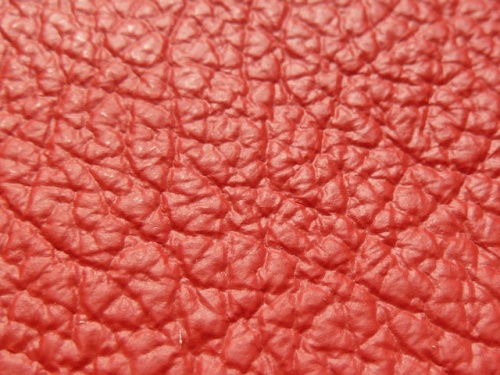
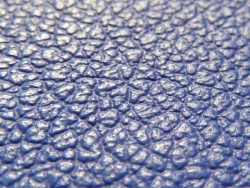
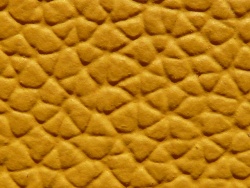
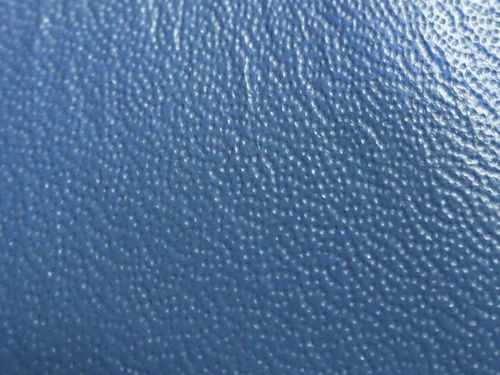
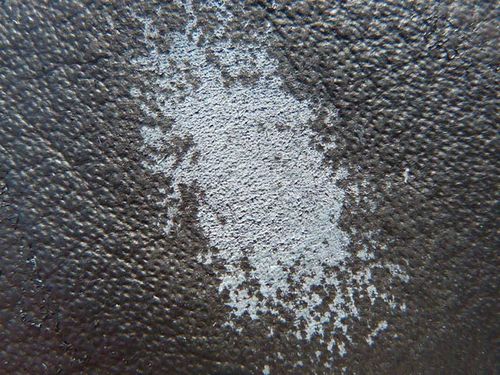
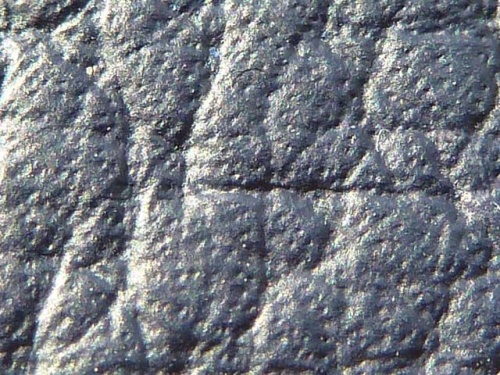
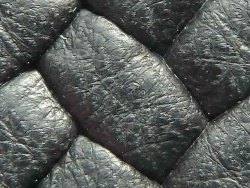
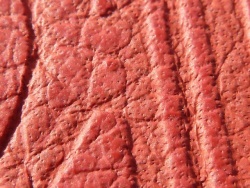

 a kotori web solution
a kotori web solution